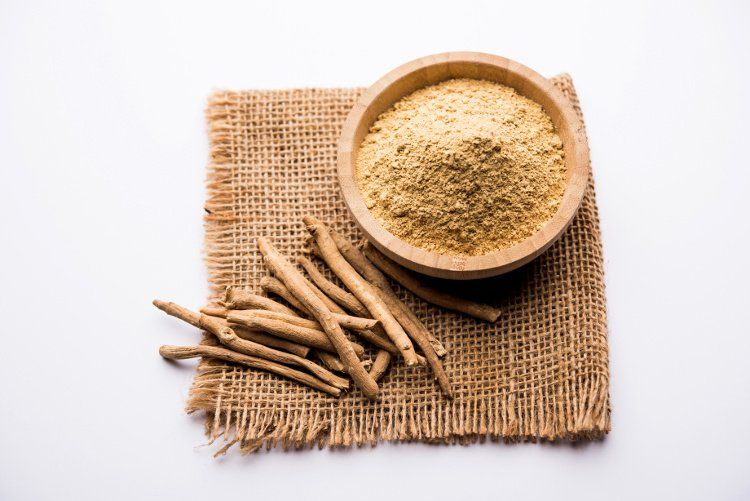Ashwagandha is going mainstream: 2020 Ingredient trends to watch for foods, drinks, and dietary supplements
Even so, more consumers need to be convinced of ashwagandha’s efficacy, safety, and benefits.
Photo © AdobeStock.com/Arundhati

You can say this about ashwagandha: It knows how to make a mainstream entrance. Last year, the ingredient surprised in an appearance on “Saturday Night Live” when guest star Gwyneth Paltrow made fun of the word ashwagandha, joking that ashwagandha originates from the “Black Panther” movie’s fictional nation of Wakanda.
All jokes aside, ashwagandha’s SNL pop-culture turn would not have been possible were it not for the growing consumer awareness and interest in this Ayurvedic herb. Ashwagandha (Withania somnifera) has entered the mainstream consumer’s consciousness, putting it on our list of Ingredients to Watch in 2020.
Last year, the American Botanical Council’s journal HerbalGram reported in its annual Herb Market Report1 that sales of ashwagandha back in 2018 grew in both the U.S. mainstream and natural retail channels. In the U.S. natural channel, ashwagandha was the 7th bestselling herbal supplement that year, growing 16.9% to $12.5 million.
Numbers provided for this story by market researcher SPINS (Chicago) show that sales of ashwagandha in the U.S. natural channel continued to grow in 2019-at 8.7% to $13.3 million in 2019, per the channels SPINS tracks. IRI (Chicago) also reported impressive sales growth for ashwagandha in 2019. During the November 2019 Council for Responsible Nutrition annual conference, the market researcher said, based on outlets it tracked, ashwagandha sales grew 66% to $7.3 million in the 52 weeks ending August 11, 2019.
Ashwagandha’s most exciting story to tell, however, may just be in the U.S. mainstream channel. HerbalGram reported that back in 2018, “strong” ashwagandha sales had pushed the ingredient to rank among the 40 top-selling ingredients in the U.S. mainstream channel for the first time. Ashwagandha hit the charts at #34, with mainstream sales growth of 166% in 2018 and total sales of nearly $7.5 million.
More consumers are learning about the benefits of ashwagandha. Said the HerbalGram report: “Ashwagandha has been one of the 40 top-selling ingredients in natural retail stores since 2015, but its appearance among the top-40 herbs in the mainstream channel in 2018 suggests more widespread familiarity among casual consumers of natural products. Mainstream ashwagandha sales in 2018 likely benefitted from the continued popularity of ingredients traditionally used in Ayurveda, the primary traditional medical system of India.”
Bruce Brown, president of ashwagandha supplier Natreon Inc. (New Brunswick, NJ), says, “It is clear that ashwagandha is growing, and some would argue it is on the verge of becoming the next curcumin in the plant-based ingredient market. The broadening consumer appeal for ashwagandha, nootropics, and adaptogens is evident with evolving news stories, trending topics in social media, and culminating with innovative consumer brands launching products containing ashwagandha.”
Chris Kilham, Medicine Hunter, and brand ambassador for ashwagandha supplier Ixoreal Biomed (Los Angeles), says: “Ashwagandha has gained greater awareness among herbal customers over the past few years due to strong promotion. Though not as well known as [other adaptogens such as] Rhodiola rosea, Panax ginseng, and eleuthero, ashwagandha is coming on very strong and has risen in the popular herbs category…”
Consumers are connecting with one of ashwagandha’s best-known benefits: stress relief. As an adaptogenic herb, ashwagandha helps the body maintain homeostasis against physiological stressors. This ability is something modern consumers are just starting to learn about-despite the fact ashwagandha has been part of Ayurvedic medicine for thousands of years.
“While plant-based adaptogens are not new, consumer awareness of hormonal balance and stress as a condition which requires natural assistance has been relatively recent,” says Benny Antony, PhD, joint managing director for ashwagandha supplier Arjuna Natural Pvt. (Kerala, India). “The condition is not easily identified as such and because of that, it was not looked upon as a matter to address. However, once this awareness came, the industry was quick to look for tried-and-tested methods. Ayurveda, with its approach of holistic wellbeing, has always been familiar with adaptogens, even before they were called ‘adaptogens.’”
Brown adds: “The category of adaptogens has only recently gained consumer awareness, yet it has grown dramatically in a short period of time across numerous applications such as beverages and supplements as well as across channels such as natural, mass market, internet/social, and practitioner. The growth of the adaptogen category is primarily driven by consumer interest in products that support the body's ability to balance naturally in response to everyday stressors (sleep, career and social pressure, etc.).”
Emerging interest is a good starting place, but it takes more to nurture an herb into the true market leader that ashwagandha could one day become. To achieve that, more consumers need to be convinced of ashwagandha’s benefits. This will require more modern research on ashwagandha-and it so happens that ashwagandha suppliers have taken the lead in investing in clinical research to explore all that their ingredients can do.
“The initial acceptance by the community of ashwagandha extracts [has] spurred more research to find more effective actives compatible to a modern world. It also encouraged companies to conduct more clinical trials,” says Michael Lelah, PhD, chief science officer, NutriScience Innovations LLC (Trumbull, CT). NutriScience is the exclusive North American supplier of Arjuna Natural’s ashwagandha ingredient Shoden.
Kilham says: “An ever-increasing body of science, coupled with repetition of benefits in as many venues as possible, will move ashwagandha even further along.” Mainstream media coverage of positive findings is also key, he adds.
What is modern research showing? Historically, ashwagandha research has focused on stress/focus/mood/sleep, muscle health, and sexual health.
In addition to studies on stress and anxiety, Arjuna Natural says it’s completed several studies on Shoden involving non-restorative sleep, exercise endurance, male vitality, immune health, and even animal health.
Ixoreal is continuing research on its KSM-66 ashwagandha ingredient in the areas of energy, stamina, enhanced mental function, reduced stress, deeper sleep, enhanced immune function, endurance, and improved athletic performance, Kilham says.
Natreon’s research on its Sensoril ashwagandha ingredient includes studies on stress, sleep, focus, energy, muscular strength, and joint health, Brown says. The company is also performing emerging research in gut health and in women, whom he says might benefit from the mood, stress, and sleep benefits ashwagandha can provide in the face of menopause-related symptoms.
And this is only the beginning, companies say. Says Brown: “Standardized ashwagandha in today’s market has only begun to explore all the health benefits of consuming ashwagandha, including cognitive and adaptogenic benefits.”
NutriScience’s Lelah adds: “As an herb, ashwagandha is definitely a treasure house and could provide direct and indirect solutions to address various lifestyle conditions such as weight management, blood sugar support, etc., but [it] will take time to clinically study and unravel.”
As more research is done on ashwagandha and its various active constituents, ashwagandha will have potential to play in many health product markets, including in supplements, foods, and even beverages like coffee.
Sleep support is already a major opportunity-not only for ashwagandha but for the dietary supplements industry at large. Brown notes that ashwagandha, as part of Ayurveda, has been used to support healthy sleep habits for thousands of years. “Ashwagandha is seen as an innovation for the sleep category, which has been defined by melatonin,” he says. As the lesser-known sleep ingredient, ashwagandha is already benefitting from melatonin’s name recognition, Brown says, with Sensoril ashwagandha already being combined with melatonin in products on the sleep shelf. Arjuna’s Antony says that the sleep category is also now a big focus for his company.
There is also interest in combining ashwagandha with hemp cannabidiol (CBD). “As the CBD market continues to evolve and differentiate, we see ashwagandha becoming a common ingredient within CBD products,” Brown says.
Kilham says, “Ashwagandha fits into formulas very well, is naturally bolstered by the other adaptogens, and works with broad-spectrum botanicals like turmeric and CBD hemp oil.”
Finally, says Brown, “Several companies have begun to further explore the benefits of ashwagandha in combination with probiotics. Nature’s Way Fortify Daily Probiotic Mood & Stress is designed to promote digestive health through probiotics as well as support relaxation and a positive mood through the addition of 250 mg of Sensoril ashwagandha. The microbiome and the connection between the gut and brain is only beginning to be explored, and we expect to see continued innovation in the digestive health category for ashwagandha.”
All of this movement will further growth of the ashwagandha market. There is still lots of room to grow.
“Ashwagandha may not be a household name, but it is getting there,” says Arjuna’s Antony. “One of the reasons for the growth of ashwagandha as an ingredient is the awareness that stress has effects across the entire body. The growing awareness of the need for a holistic approach to health is lifting the consumer segment up-and ashwagandha along with it.”
Of course, when an ingredient becomes popular, it also becomes vulnerable to economic adulteration, and here, companies making ashwagandha products should be wary of low-quality ingredients on the market. Unfortunately, says Kilham, not all are aware. Incentives for adulteration are ripe, he says. For instance, “Shortage of supply due to heavy rains last year will plague manufacturers this year.”
Making ashwagandha a household name will take commitment from all who buy and sell this ingredient to not only increase consumer awareness but to protect the integrity of the market. To that end, NutriScience’s Lelah warns, “We commonly see plain ashwagandha powder and low-active ingredients being marketed in the ashwagandha space, which apart from possibly only having a placebo effect also dents consumer confidence in all supplements.” He adds: “The ‘plain powder’ and low-active products are a concern in this area as there is no traceability. Also, once powdered, it would be very difficult to find adulterants.”
Brown emphasizes that the ashwagandha market needs to continue to invest in cultivating and sourcing the highest-quality ashwagandha plants possible.
Manufacturers must also help teach consumers about the importance of the active components in ashwagandha and their bioactivity, Lelah says. “Consumer education is a slow process,” he says. “Consumers do understand there are actives, but the ‘last mile’ enlightenment is challenging.”
“While ashwagandha has been around for thousands of years, it is still relatively new in the mainstream market,” says Arjuna’s Antony. “Consumers are just learning about its benefits, and they still have a lot to learn, as do manufacturers. As more research is conducted, ashwagandha will likely fit into new product categories, thus fueling more growth for the unique ingredient.”
Brown says: “Our belief is, we are just at the beginning of the journey for ashwagandha.”
2020 Ingredient Trends to Watch for Food, Drinks, and Dietary Supplements:
CBDElderberryMelatoninMCTsMagnesium
Ashwagandha
CollagenDietary Fiber/Prebiotics
References:
- Smith T. “Herbal supplement sales in US increase by 9.4% in 2018.” HerbalGram, no. 123 (2019). Accessed at: http://cms.herbalgram.org/herbalgram/issue123/files/HG123-HMR.pdf

Polyphenols: The next generation of prebiotics is ready for liftoff
April 21st 2025Explore the prebiotic health benefits of polyphenols and the positive impact they may have on digestive and immune health. Polyphenols, such as those found in European black elderberry, may be an ideal solution for manufacturers trying to break into the digestive health space.
























